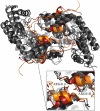Molecular defects of the glycine 41 variants of alanine glyoxylate aminotransferase associated with primary hyperoxaluria type I
- PMID: 20133649
- PMCID: PMC2840350
- DOI: 10.1073/pnas.0908565107
Molecular defects of the glycine 41 variants of alanine glyoxylate aminotransferase associated with primary hyperoxaluria type I
Abstract
G41 is an interfacial residue located within the alpha-helix 34-42 of alanine:glyoxylate aminotransferase (AGT). Its mutations on the major (AGT-Ma) or the minor (AGT-Mi) allele give rise to the variants G41R-Ma, G41R-Mi, and G41V-Ma causing hyperoxaluria type 1. Impairment of dimerization in these variants has been suggested to be responsible for immunoreactivity deficiency, intraperoxisomal aggregation, and sensitivity to proteasomal degradation. However, no experimental evidence supports this view. Here we report that G41 mutations, besides increasing the dimer-monomer equilibrium dissociation constant, affect the protein conformation and stability, and perturb its active site. As compared to AGT-Ma or AGT-Mi, G41 variants display different near-UV CD and intrinsic emission fluorescence spectra, larger exposure of hydrophobic surfaces, sensitivity to Met53-Tyr54 peptide bond cleavage by proteinase K, decreased thermostability, reduced coenzyme binding affinity, and catalytic efficiency. Additionally, unlike AGT-Ma and AGT-Mi, G41 variants under physiological conditions form insoluble inactive high-order aggregates (approximately 5,000 nm) through intermolecular electrostatic interactions. A comparative molecular dynamics study of the putative structures of AGT-Mi and G41R-Mi predicts that G41 --> R mutation causes a partial unwinding of the 34-42 alpha-helix and a displacement of the first 44 N-terminal residues including the active site loop 24-32. These simulations help us to envisage the possible structural basis of AGT dysfunction associated with G41 mutations. The detailed insight into how G41 mutations act on the structure-function of AGT may contribute to achieve the ultimate goal of correcting the effects of these mutations.
Conflict of interest statement
The authors declare no conflict of interest.
Figures






Similar articles
-
Misfolding caused by the pathogenic mutation G47R on the minor allele of alanine:glyoxylate aminotransferase and chaperoning activity of pyridoxine.Biochim Biophys Acta. 2015 Oct;1854(10 Pt A):1280-9. doi: 10.1016/j.bbapap.2015.07.002. Epub 2015 Jul 3. Biochim Biophys Acta. 2015. PMID: 26149463
-
Effects of interface mutations on the dimerization of alanine glyoxylate aminotransferase and implications in the mistargeting of the pathogenic variants F152I and I244T.Biochimie. 2016 Dec;131:137-148. doi: 10.1016/j.biochi.2016.10.001. Epub 2016 Oct 5. Biochimie. 2016. PMID: 27720751
-
Gly161 mutations associated with Primary Hyperoxaluria Type I induce the cytosolic aggregation and the intracellular degradation of the apo-form of alanine:glyoxylate aminotransferase.Biochim Biophys Acta. 2013 Dec;1832(12):2277-88. doi: 10.1016/j.bbadis.2013.09.002. Epub 2013 Sep 17. Biochim Biophys Acta. 2013. PMID: 24055001
-
Human liver peroxisomal alanine:glyoxylate aminotransferase: characterization of the two allelic forms and their pathogenic variants.Biochim Biophys Acta. 2011 Nov;1814(11):1577-84. doi: 10.1016/j.bbapap.2010.12.005. Epub 2010 Dec 20. Biochim Biophys Acta. 2011. PMID: 21176891 Review.
-
Alanine glyoxylate aminotransferase deficiency: biochemical and molecular genetic lessons from the study of a human disease.Adv Enzyme Regul. 1992;32:309-27. doi: 10.1016/0065-2571(92)90024-t. Adv Enzyme Regul. 1992. PMID: 1496924 Review.
Cited by
-
Molecular recognition of PTS-1 cargo proteins by Pex5p: implications for protein mistargeting in primary hyperoxaluria.Biomolecules. 2015 Feb 13;5(1):121-41. doi: 10.3390/biom5010121. Biomolecules. 2015. PMID: 25689234 Free PMC article.
-
Phosphorylation in the catalytic cleft stabilizes and attracts domains of a phosphohexomutase.Biophys J. 2015 Jan 20;108(2):325-37. doi: 10.1016/j.bpj.2014.12.003. Biophys J. 2015. PMID: 25606681 Free PMC article.
-
Development and characterization of a glycine biosensor system for fine-tuned metabolic regulation in Escherichia coli.Microb Cell Fact. 2022 Apr 7;21(1):56. doi: 10.1186/s12934-022-01779-4. Microb Cell Fact. 2022. PMID: 35392910 Free PMC article.
-
Structural dynamics shape the fitness window of alanine:glyoxylate aminotransferase.Protein Sci. 2022 May;31(5):e4303. doi: 10.1002/pro.4303. Protein Sci. 2022. PMID: 35481644 Free PMC article.
-
Protein homeostasis defects of alanine-glyoxylate aminotransferase: new therapeutic strategies in primary hyperoxaluria type I.Biomed Res Int. 2013;2013:687658. doi: 10.1155/2013/687658. Epub 2013 Jul 16. Biomed Res Int. 2013. PMID: 23956997 Free PMC article. Review.
References
-
- Zhang X, et al. Crystal structure of alanine:glyoxylate aminotransferase and the relationship between genotype and enzymatic phenotype in primary hyperoxaluria type 1. J Mol Biol. 2003;331(3):643–652. - PubMed
-
- Motley A, et al. Mammalian alanine/glyoxylate aminotransferase 1 is imported into peroxisomes via the PTS1 translocation pathway. Increased degeneracy and context specificity of the mammalian PTS1 motif and implications for the peroxisome-to-mitochondrion mistargeting of AGT in primary hyperoxaluria type 1. J Cell Biol. 1995;131(1):95–109. - PMC - PubMed
-
- Danpure CJ. Molecular etiology of primary hyperoxaluria type 1: New directions for treatment. Am J Nephrol. 2005;25(3):303–310. - PubMed
Publication types
MeSH terms
Substances
LinkOut - more resources
Full Text Sources
Molecular Biology Databases
Research Materials
Miscellaneous

